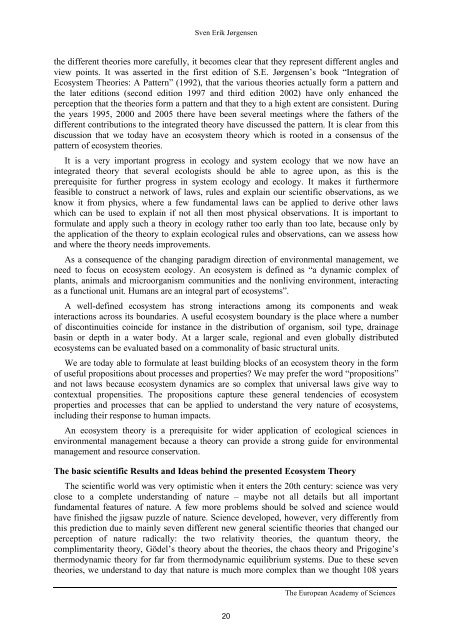An Integrated Ecosystem Theory - European Academy of Sciences
An Integrated Ecosystem Theory - European Academy of Sciences
An Integrated Ecosystem Theory - European Academy of Sciences
Create successful ePaper yourself
Turn your PDF publications into a flip-book with our unique Google optimized e-Paper software.
Sven Erik Jørgensen<br />
the different theories more carefully, it becomes clear that they represent different angles and<br />
view points. It was asserted in the first edition <strong>of</strong> S.E. Jørgensen’s book “Integration <strong>of</strong><br />
<strong>Ecosystem</strong> Theories: A Pattern” (1992), that the various theories actually form a pattern and<br />
the later editions (second edition 1997 and third edition 2002) have only enhanced the<br />
perception that the theories form a pattern and that they to a high extent are consistent. During<br />
the years 1995, 2000 and 2005 there have been several meetings where the fathers <strong>of</strong> the<br />
different contributions to the integrated theory have discussed the pattern. It is clear from this<br />
discussion that we today have an ecosystem theory which is rooted in a consensus <strong>of</strong> the<br />
pattern <strong>of</strong> ecosystem theories.<br />
It is a very important progress in ecology and system ecology that we now have an<br />
integrated theory that several ecologists should be able to agree upon, as this is the<br />
prerequisite for further progress in system ecology and ecology. It makes it furthermore<br />
feasible to construct a network <strong>of</strong> laws, rules and explain our scientific observations, as we<br />
know it from physics, where a few fundamental laws can be applied to derive other laws<br />
which can be used to explain if not all then most physical observations. It is important to<br />
formulate and apply such a theory in ecology rather too early than too late, because only by<br />
the application <strong>of</strong> the theory to explain ecological rules and observations, can we assess how<br />
and where the theory needs improvements.<br />
As a consequence <strong>of</strong> the changing paradigm direction <strong>of</strong> environmental management, we<br />
need to focus on ecosystem ecology. <strong>An</strong> ecosystem is defined as “a dynamic complex <strong>of</strong><br />
plants, animals and microorganism communities and the nonliving environment, interacting<br />
as a functional unit. Humans are an integral part <strong>of</strong> ecosystems”.<br />
A well-defined ecosystem has strong interactions among its components and weak<br />
interactions across its boundaries. A useful ecosystem boundary is the place where a number<br />
<strong>of</strong> discontinuities coincide for instance in the distribution <strong>of</strong> organism, soil type, drainage<br />
basin or depth in a water body. At a larger scale, regional and even globally distributed<br />
ecosystems can be evaluated based on a commonality <strong>of</strong> basic structural units.<br />
We are today able to formulate at least building blocks <strong>of</strong> an ecosystem theory in the form<br />
<strong>of</strong> useful propositions about processes and properties We may prefer the word “propositions”<br />
and not laws because ecosystem dynamics are so complex that universal laws give way to<br />
contextual propensities. The propositions capture these general tendencies <strong>of</strong> ecosystem<br />
properties and processes that can be applied to understand the very nature <strong>of</strong> ecosystems,<br />
including their response to human impacts.<br />
<strong>An</strong> ecosystem theory is a prerequisite for wider application <strong>of</strong> ecological sciences in<br />
environmental management because a theory can provide a strong guide for environmental<br />
management and resource conservation.<br />
The basic scientific Results and Ideas behind the presented <strong>Ecosystem</strong> <strong>Theory</strong><br />
The scientific world was very optimistic when it enters the 20th century: science was very<br />
close to a complete understanding <strong>of</strong> nature – maybe not all details but all important<br />
fundamental features <strong>of</strong> nature. A few more problems should be solved and science would<br />
have finished the jigsaw puzzle <strong>of</strong> nature. Science developed, however, very differently from<br />
this prediction due to mainly seven different new general scientific theories that changed our<br />
perception <strong>of</strong> nature radically: the two relativity theories, the quantum theory, the<br />
complimentarity theory, Gödel’s theory about the theories, the chaos theory and Prigogine’s<br />
thermodynamic theory for far from thermodynamic equilibrium systems. Due to these seven<br />
theories, we understand to day that nature is much more complex than we thought 108 years<br />
The <strong>European</strong> <strong>Academy</strong> <strong>of</strong> <strong>Sciences</strong><br />
20


